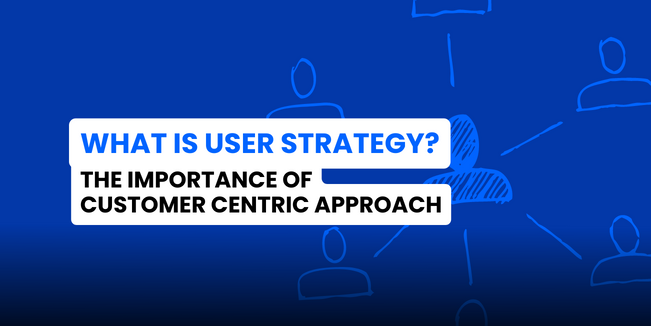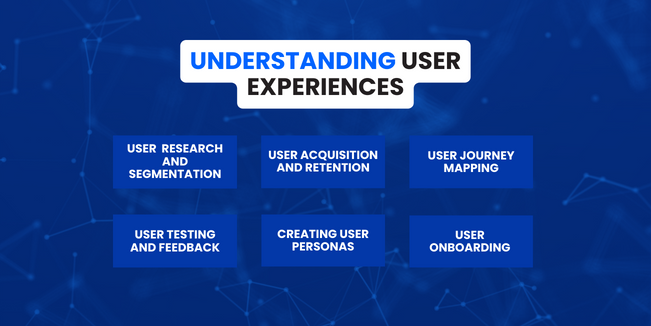What is user strategy? The importance of customer centric approach

A user strategy is a crucial component for businesses and products aiming to thrive in today's digital landscape. By definition, user strategy refers to the deliberate planning and execution of a well-thought-out approach to cater to the needs and expectations of target users.
Incorporating a user strategy into your business or product development process is of utmost importance. It enables you to align your offerings with what the users truly desire and enhance their overall experience. When businesses prioritize user-centricity, they have the opportunity to gain a competitive edge, foster customer loyalty, and ultimately achieve sustainable growth.
By understanding the user's perspective, behavior, and preferences, a solid user strategy helps you tailor your marketing efforts, improve product usability, and make informed business decisions. This holistic approach drives higher customer satisfaction, boosts conversion rates, and fosters positive brand reputation.
In this article, we will delve deeper into the concept of user strategy and its invaluable benefits for businesses. Join us as we explore practical tips, case studies, and industry insights to craft a winning user strategy that propels your business to new heights.
The role of user strategy in business planning
User strategy plays a vital role in the overall success of a business. It involves aligning the goals and objectives of the organization with the needs and expectations of its target users. By understanding the importance of user strategy, businesses can gain a competitive advantage and achieve sustainable growth.
How user strategy aligns with overall business goals
When developing a user strategy, it is essential to consider how it aligns with the overall goals and objectives of the business. The user strategy should not operate independently but complement the larger business strategy. By aligning the user strategy with the business goals, organizations can ensure that their efforts yield meaningful results and contribute to the overall success of the business.
Identifying target users and their needs
One of the key components of user strategy is identifying the target users and understanding their needs. This information is crucial for creating products and services that cater to their needs, ultimately driving customer satisfaction and loyalty.
Mapping user behavior and engagement to business objectives
User strategy involves mapping user behavior and engagement to specific business objectives. By monitoring user interactions and analyzing user feedback, businesses can align their strategies with user preferences. This helps to optimize user experiences and drive desired business outcomes, such as increased conversions, higher retention rates, and improved customer satisfaction.
In conclusion, user strategy is a critical component of business planning. It ensures that organizations effectively meet the needs of their target users and align their efforts with the overall goals of the business. By implementing a comprehensive user strategy, businesses can enhance user experiences, drive customer satisfaction, and achieve long-term success.
Understanding user experiences

In order to create a successful user strategy, it is crucial to understand the experiences users have when interacting with a product or service. By gaining insights into their needs and expectations, businesses can design experiences that resonate with their target audience, ultimately leading to increased satisfaction and loyalty.
Significance of creating positive user experiences
Positive user experiences are essential for business success. When users have a seamless and enjoyable experience, they are more likely to engage with a product or service, make repeat purchases, and recommend it to others. On the other hand, negative experiences can result in lost customers and damaged reputation.
Incorporating user-centric design principles into strategy
A user-centric design approach focuses on understanding users' goals, behaviors, and preferences. By incorporating these principles into the overall user strategy, businesses can tailor their offerings to meet user needs effectively. This user centered design strategy can involve intuitive navigation, responsive design, and personalized experiences.
Utilizing user feedback for enhancing experiences
User feedback is a valuable resource for businesses to improve and optimize their user experiences. By listening to the voice of the user, businesses can identify pain points, understand what works well, and make informed decisions to enhance their products or services. This can be done through surveys, user testing, and analyzing customer support interactions.
User research and segmentation
Understanding your audience is crucial in developing an effective user strategy. By conducting user research and segmentation, you can gain valuable insights into the needs, preferences, and behaviors of your target users. This information allows you to tailor your strategies for different user segments, enhancing user experiences and driving business success.
Conducting user research to gain insights
Effective user research involves gathering data and feedback directly from your target users. This can be done through various methods such as surveys, interviews, usability testing, and analyzing user behavior on your website or app. By understanding the challenges, motivations, and pain points of your users, you can make informed decisions to improve your products or services.
Segmenting user groups based on attributes and behaviors
Segmentation involves dividing your target users into distinct groups based on shared characteristics, behaviors, or needs. This could be done by demographic factors, such as age, gender, or location, or psychographic factors, such as interests, values, or lifestyle. By segmenting your users, you can create targeted marketing campaigns and personalized experiences that resonate with each group.
Tailoring strategies according to different user segments
Once you have identified your user segments, it's important to develop tailored strategies that address the specific needs and preferences of each group. This could involve adjusting your messaging, design, or functionality to better align with their expectations. By catering to the unique requirements of each segment, you can enhance user satisfaction and drive long-term loyalty.
User acquisition and retention
In order to successfully grow a business, it is crucial to develop effective user acquisition and retention strategies. This involves attracting new users and implementing tactics to keep them engaged and loyal. Additionally, analyzing user analytics can help optimize these efforts.
Developing strategies to attract new users
One key aspect of user acquisition is creating strategies to attract new users to your business. This can include various tactics such as targeted advertising, social media marketing, content marketing, and search engine optimization. By understanding your target audience and their preferences, you can tailor your approach to effectively reach and attract potential users.
Implementing tactics for user retention and loyalty
Retaining users and building customer loyalty is equally important as attracting new users. By providing a positive user experience, delivering exceptional customer service, and offering rewards and incentives, you can encourage users to continue using your products or services. Additionally, implementing customer retention tactics such as personalized marketing campaigns and loyalty programs can help foster long-term relationships with your users.
Analyzing user analytics to optimize acquisition and retention efforts
Effective user acquisition and retention strategies rely on data and analytics. By closely monitoring user behavior, engagement metrics, and conversion rates, you can gain valuable insights into the effectiveness of your efforts. This data can help you identify areas for improvement and optimize your acquisition and retention strategies for better results. Regularly analyzing and benchmarking your user analytics will enable you to make data-driven decisions and refine your user strategy.
User journey mapping
In order to effectively create and implement a user strategy, it is crucial to understand the user journey. Mapping out the user journey allows businesses to gain valuable insights into how their customers interact with their product or service.
Importance of mapping user journeys
User journey mapping is essential because it helps businesses identify each step in a customer's interaction with their brand. By understanding the user journey, businesses can identify pain points and areas for improvement.
Identifying touchpoints and pain points in the user journey
Through user journey mapping, businesses can visually identify all the touchpoints that a customer encounters when engaging with their brand. This includes interactions through various channels such as websites, social media, and customer service.
Moreover, user journey mapping also helps businesses identify pain points in the customer's journey. These pain points are obstacles or challenges that customers face during their interaction with the brand. Identifying these pain points allows businesses to address them and provide better user experiences.
Enhancing user experiences through targeted interventions
Once pain points are identified, businesses can then work on enhancing user experiences through targeted interventions. This can involve improving website navigation, streamlining the checkout process, or providing better customer support.
By making targeted interventions at touchpoints and pain points, businesses can create a seamless user journey that improves customer satisfaction and increases the likelihood of retention.
User testing and feedback
Conducting user testing is a crucial step in evaluating the usability of a product. By observing users as they interact with the product, we can identify any issues or areas of improvement. User testing helps us understand how users navigate through the product, what features they struggle with, and what improvements can be made to enhance their experience.
Gathering and analyzing user feedback is another key aspect of user testing. Through surveys, interviews, and usability testing sessions, we collect valuable insights from users about their preferences, needs, and pain points. This feedback allows us to make iterative improvements to the product, ensuring that it caters to the users' expectations and requirements.
Incorporating user feedback into the design and planning process is vital for creating a user-centric product. By listening to the users and considering their suggestions, we can refine the design and make informed decisions that prioritize user satisfaction. User feedback serves as a compass, guiding us towards the right direction and helping us avoid potential pitfalls.
Creating user personas
Defining user personas based on research and segmentation is a crucial step in developing an effective user strategy. User personas are fictional representations of your target users, created to better understand their demographics, needs, and motivations.
By conducting thorough user research and segmentation, you can gather valuable data about your target audience. This data includes information such as age, gender, location, occupation, and interests. Additionally, you can gain insights into their goals, challenges, and pain points.
Once you have collected this information, you can use it to create specific user personas. A user persona typically includes a name, a photo, and a brief background story that represents a specific segment of your target audience.
Understanding user demographics, needs, and motivations allows you to tailor your content and experiences to address the specific interests and goals of each user persona. For example, if you have identified a persona who values simplicity and efficiency, you can design your website or app with a clean and intuitive user interface.
By catering to the unique characteristics and preferences of each user persona, you can create a more personalized and engaging experience. This, in turn, increases the likelihood of building strong connections with your target audience and driving desired actions.
User onboarding and engagement
Designing effective user onboarding experiences is crucial for any business looking to attract and retain customers. The onboarding process is the first interaction users have with a product or service, and it sets the tone for their overall experience. A smooth and intuitive onboarding experience can help users understand the value and benefits of the product, leading to higher adoption rates and increased customer satisfaction.
One strategy for improving user engagement and satisfaction is personalization. By tailoring the onboarding experience to each user's specific needs and preferences, businesses can create a more personalized and relevant experience. This can be achieved through targeted messaging, personalized recommendations, and customized user interfaces.
Another strategy for improving user engagement is providing ongoing support and guidance. Users should have access to clear and concise instructions, tutorials, and FAQs to help them navigate the product or service. Offering proactive assistance, such as live chat support or personalized email campaigns, can also help users overcome any challenges they may encounter and foster a sense of trust and loyalty.
Measuring success in user onboarding and engagement requires the use of user metrics and satisfaction surveys. Metrics such as user activation rate, time to first value, and user retention rate can provide insights into how well the onboarding process is working and whether users are finding value in the product or service. Satisfaction surveys can also help identify areas for improvement and gather feedback directly from users.
Integrating user strategy into overall business strategy
-
Aligning user strategy with other user and business needs and strategies
-
Collaboration between business, design, and strategy teams
-
Continual monitoring conduct user research and optimization of user strategy
Why is user experience strategy important?
In today's digital landscape, user strategy has become a crucial element in business planning. It serves as the foundation for creating exceptional user experiences that not only attract new users but also retain them.
By implementing a well-defined user strategy, businesses can ensure that their products or services align with the needs and preferences of their target audience. This, in turn, leads to increased user satisfaction, brand loyalty, market share, and ultimately, business success.
Benefits of implementing user-centric approaches
Implementing user-centric approaches, such as user research, segmentation, and user journey mapping, can offer numerous benefits for businesses. Firstly, it allows them to gain a deeper understanding of their users and their unique needs, enabling them to tailor their products or services accordingly.
Secondly, a user-centric approach helps in creating personalized and engaging experiences, leading to increased user acquisition and retention rates. By prioritizing the needs and desires of their users, businesses can build stronger relationships and cultivate brand advocacy.
Considerations for ongoing user strategy development
Developing a user strategy is an ongoing process that requires continuous evaluation, adaptation, and improvement. Businesses must stay updated with evolving user preferences, technological advancements, and market trends to ensure the effectiveness of their user strategy.
Regular user testing and feedback play a vital role in fine-tuning the user strategy. By actively seeking input from users, businesses can identify pain points, gather insights, and make informed decisions to enhance the end user and experience continuously.
In conclusion, adopting a user-centric approach is integral to unlocking success in today's competitive business landscape. By prioritizing user strategy, businesses can create exceptional experiences that not only meet but exceed user expectations, resulting in sustainable growth and customer loyalty
mDevelopers – your impeccable partner in software development

At mDevelopers we provide business with help to establish the most appropriate customer-centric strategy. We provide clients with Discovery Workshop where all the nuances and questions will be answered. We also work closely with cross-functional teams to incorporate data-driven insights into the development process, giving businesses the ability to make wise choices that result in a more successful user strategy. Ultimately, by bridging the gap between technical prowess and user-focused considerations, mDevelopers helps to improve user pleasure, retention, and overall product success.